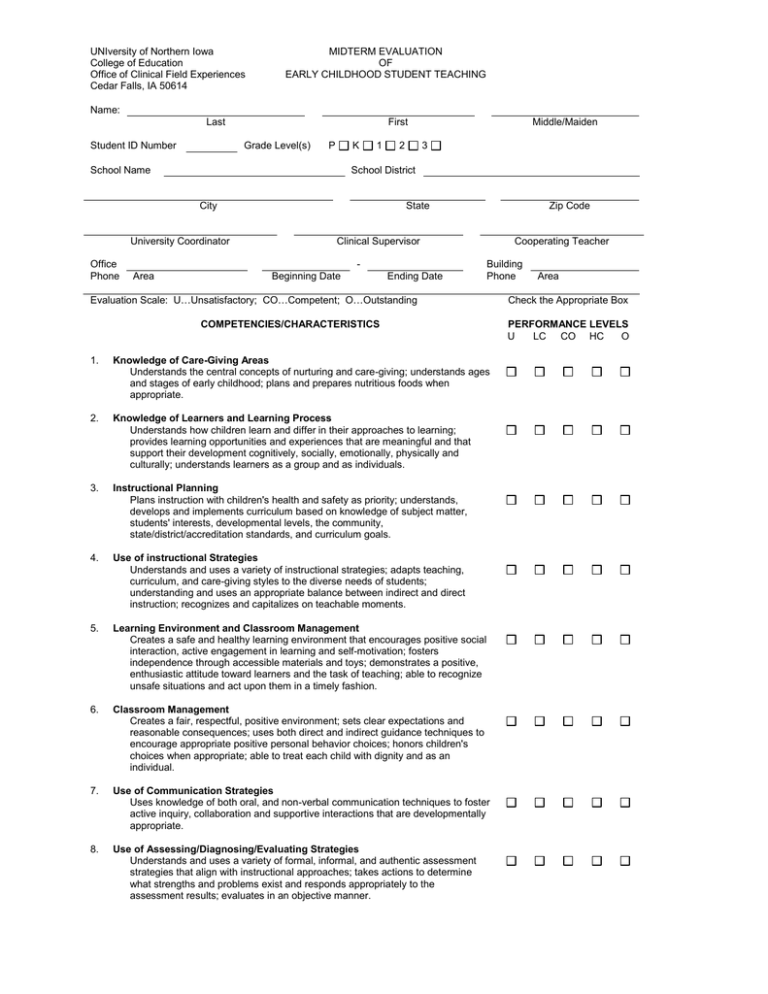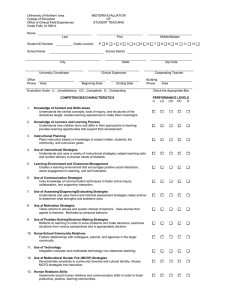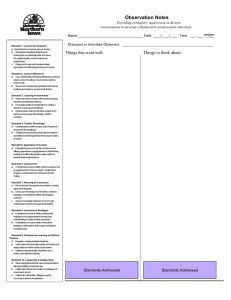Document 13937380
advertisement

UNIversity of Northern Iowa College of Education Office of Clinical Field Experiences Cedar Falls, IA 50614 MIDTERM EVALUATION OF EARLY CHILDHOOD STUDENT TEACHING Name: Last Student ID Number First Grade Level(s) P K School Name 1 3 School District City University Coordinator Office Phone 2 Middle/Maiden State Clinical Supervisor - Area Zip Code Beginning Date Ending Date Cooperating Teacher Building Phone Evaluation Scale: U…Unsatisfactory; CO…Competent; O…Outstanding COMPETENCIES/CHARACTERISTICS 1. Knowledge of Care-Giving Areas Understands the central concepts of nurturing and care-giving; understands ages and stages of early childhood; plans and prepares nutritious foods when appropriate. 2. Knowledge of Learners and Learning Process Understands how children learn and differ in their approaches to learning; provides learning opportunities and experiences that are meaningful and that support their development cognitively, socially, emotionally, physically and culturally; understands learners as a group and as individuals. 3. Instructional Planning Plans instruction with children's health and safety as priority; understands, develops and implements curriculum based on knowledge of subject matter, students' interests, developmental levels, the community, state/district/accreditation standards, and curriculum goals. 4. Use of instructional Strategies Understands and uses a variety of instructional strategies; adapts teaching, curriculum, and care-giving styles to the diverse needs of students; understanding and uses an appropriate balance between indirect and direct instruction; recognizes and capitalizes on teachable moments. 5. Learning Environment and Classroom Management Creates a safe and healthy learning environment that encourages positive social interaction, active engagement in learning and self-motivation; fosters independence through accessible materials and toys; demonstrates a positive, enthusiastic attitude toward learners and the task of teaching; able to recognize unsafe situations and act upon them in a timely fashion. 6. Classroom Management Creates a fair, respectful, positive environment; sets clear expectations and reasonable consequences; uses both direct and indirect guidance techniques to encourage appropriate positive personal behavior choices; honors children's choices when appropriate; able to treat each child with dignity and as an individual. 7. Use of Communication Strategies Uses knowledge of both oral, and non-verbal communication techniques to foster active inquiry, collaboration and supportive interactions that are developmentally appropriate. 8. Use of Assessing/Diagnosing/Evaluating Strategies Understands and uses a variety of formal, informal, and authentic assessment strategies that align with instructional approaches; takes actions to determine what strengths and problems exist and responds appropriately to the assessment results; evaluates in an objective manner. Area Check the Appropriate Box PERFORMANCE LEVELS U LC CO HC O 9. Use of Motivation Strategies Uses multiple techniques, materials, and settings to kindle and sustain interest of learners; motivates by personal behavior; able to identify interest and noninterest behaviors and respects them. 10. Use of Problem-Solving/Decision Making Strategies Reflects on teaching during and after lessons in order to recognize and solve problems and make decisions; examines situations from various perspectives and is appropriately decisive; able to seek out information from others and other sources to solve instructional or behavioral problems. 11. Home-School-Community Relations Fosters relationships with colleagues, parents, and, as needed, agencies in the larger community. 12. Use of Technology Integrates the computer and other high- and low-technology into preparation, classroom teaching activities, assessment and/or documentation. 13. Use of Multicultural Gender Fair (MCGF) Strategies Demonstrates sensitivity to family, community diversity and cultural identity; infuses MCGF strategies into all professional interactions. 14. Human Relations Skills Implements sound human relations and communication skills in order to foster productive, positive learning communities. 15. Professional Characteristics/Personal Qualities Exhibits high quality characteristics in professional and personal demeanor; professional behavior exemplifies role awareness and ethical conduct; takes initiative, recognizes and functions in the role of leader, or as an integral part of the staff, and takes on the appropriate role at the required time. COMMENTS: SIGNATURES University Coordinator Clinical Supervisor Cooperating Teacher



